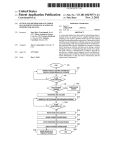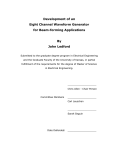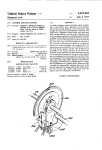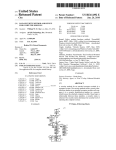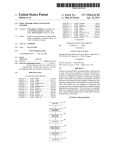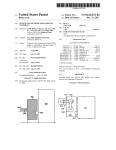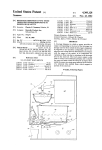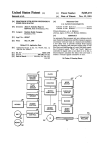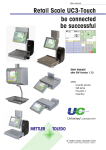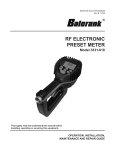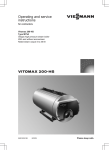Download Foodstuff vending apparatus employing improved solid
Transcript
. United States Patent [191 [l 11 4,265,371 Desai et a]. [45] May 5, 1981 [54] FOODSTUFF VENDING APPARATUS EMPLOYING IMPROVED SOLIDSTATE 3,777,937 4,011,967 TYPE CONTROL APPARATUS [75] Inventors: Mahendrakumar 1). Desai, Colonia, N.J.; Drew Henderson, Georgetown, Com [73] Assigneei Trafalgar Industries Inc" New York’ N-Y~ l2/l973 3/1977 Buck .................................... .. 222/70 Halsey et a]. ........................ .. 222/70 Primary Examiner—Joseph J. Rolla Alwmey. Agem- or Firm-Lerner. David, Lirrenberg & Samuel [57] ABSTRACT Foodstuff vending apparatus employing improved so lid-state control is provided in accordance with the [21] AppL No’: 949,052 teachings of the present invention. In accordance with _ the teachings of the present invention, a processor and [22] plied: [51] [52] Int. Cl.3 ............................................. .. B67D 5/06 us. Cl. ................................. .. 222/70; 222/1294; 3(,4/9()() Field of Search .................. .. 222/70, 1294-1294, ing to Occur in a Programmed sequenc? in accord with selected vending conditions The processor and mm ory are programmed in a manner to ascertain when a vending Operation is about to be initiated and thereafter 222/52, 59, 75; 364/900 to invite an operator to specify a product to be vended [58] 08' 6’ 1978 accompanying memory are relied upon to cause vend , and conditions under which such product is to be [56] References C'ted US. PATENT DOCUMENTS 3,409,176 ll/l968 Krause ........................ .. 222/1294 x Coja __________ u 3,638,832 3,688,947 2/l972 9/1972 REAL TIME SERVICE x selectable rates Sauber et a]. 222/76 X Reichenberger ........... .. 222/ 129.1 X TIMER lOMlLLSEwNDS I060 (RT SERV) vended. Elements of the product to be vended are then dispensed, under program control, in accordance with the Product designated and the. conditions speci?ed at HARDWARE TIMER TIME TIMER STACK Ho 42 Claims, 3 Drawing Figures START TIMER "3b ACTIVE DECREMENT COUNT START RETURN TO EXECUTIVE || CUE STACK (TASKS) l2 PUT TASK IN CUE STACK "30 are readily Vii-"able. U.S. Patent P Plcl 2 PI 1/ May 5, 1981 Sheet 1 013 4,265,371 P10 1111111111 PMEmDF mOwFzdEh FIG. lo US. Patent May 5, 1981 Sheet 3 of 3 4,265,371 7923m zww2962 uF25 6 5EQ58 ._zwsmo P230 NQE 4,265,371 1 2 of the apparatus, and, at the same time, increasing the FOODSTUFF VENDING APPARATUS EMPLOYING IMPROVED SOLID-STATE TYPE CONTROL APPARATUS BACKGROUND OF THE INVENTION Automatic vending machines are quite well known and are employed in just about every conceivable physi cal location such as, for example, factories, office build ings, institutional and education facilities, retail estab lishments, public gathering places, airport terminals, train stations, and the like. Automatic vending machines are utilized to vend a wide variety of items, including solid, as well as liquid based foodstuffs. Vending ma chines for vending liquid based foodstuffs such as hot and cold drinks, soup, and the like, typically offer a selection of foodstuff ingredients which may be com bined with a liquid or selections wherein the liquid may be combined with one or more foodstuffs added in vary ing degrees of strength or concentration in accordance with the particular selection. For example, a coffee vending machine may offer black coffee, coffee with capability and versatility of the vending apparatus. The microcomputer includes memory means for stor ing a program adapted to initiate all of the vending machine functions typically performed either mechani cally or electromechanically in conventional vending apparatus, as well as incorporating new and unique functions and capabilities to provide equipment which is less complicated from a maintenance and servicing viewpoint and which is more reliable due to the signi? cant reduction in the number of mechanical and electro mechanical components utilized in the system, as well as providing flexibility not capable of being attained with conventional apparatus. As is the case with conventional equipment, opera tion is begun by the insertion of a coin. Recognition and acceptance of a valid coin invites the apparatus operator to select the desired drink and its ingredients and/or strength of ingredients. The program provides for the 20 multiplexed use of a common bank of switches such that, in one preferred embodiment, a bank of eight switches are operated to provide up to 24 different selections, if desired. cream, coffee with sugar and cream, etc. As regards Based upon the particular selection, the program concentration, the machine may offer coffee with 25 follows the appropriate program routines associated cream, coffee with extra or double cream, coffee with with the selections made. For example, upon selection sugar, coffee with double sugar, and so forth. of a particular hot drink, the appropriate amount of The amount of each ingredient dispensed is conven liquid and other ingredients making up the drink are tionally controlled by cam operated switches which dispensed into a common mixing bowl which, in turn, control the duration of energization of a dispensing 30 dispenses the admixed ingredients into a common recep device. For example, in locations in which it is required tacle. Each of the ingredients is dispensed substantially that an eight ounce drink is to be dispensed, the liquid is simultaneously or in overlapping intervals, although in passed therethrough at a predetermined flow rate. By certain instances, some ingredients may be dispensed in adjustment of the cam operated switch means, the valve sequential fashion. The dispensing interval for each may be energized, i.e., maintained in the open position, 35 ingredient is basically a function of the amount of the for an interval which is related to the ?ow rate so as to ingredient to be dispensed. For hot drinks, the hot water be sufficient to dispense the desired quantity of liquid. is typically dispensed over the longest time interval in Similar cam operated switches are utilized to control the interval of energization during which powdered order to serve as the admixing medium, as well as the liquid based ingredient of the drink. ingredient dispensing means are maintained operative to 40 Determination of the quantity of liquid and of the dispense the proper quantity of the powdered ingredi ingredients to be dispensed, as well as the simplified and ent. yet precision adjustment of the amount of ingredient to Typically, it becomes necessary to make adjustments be dispensed, is accomplished through the cooperative in the cam operated switches in order to control the relationship of the microcomputer in cooperation with amount of the ingredient being dispensed to compensate 45 settable switch means. For example, in order to dispense for differences in dispensing devices, etc., and, although a desired amount of liquid, the program, at a predeter the cam assemblies are designed to be adjusted, such adjustments are quite difficult and require “cut and try” techniques before the proper adjustment is obtained, thus making maintenance and/or machine installation a tedious and complicated procedure. The overall number of mechanical switches neces sary to provide the desired number of selections further complicates the vending machine. In addition, mechani mined point in the routine, develops a dispensing con trol signal to initiate operation of a solenoid or a motor, for example, depending on the particular ingredient. 50 The processor also causes a scan signal to be applied to the input of each switch means associated with those ingredients to be dispensed. The scan signal appears at one of the plurality of outputs of the switch, dependent upon the setting of the adjustable switch arm. This cal switches of both the selection and cam operated 55 output is converted into a time value and is stored in a type are subject to wearing, requiring added mainte nance activity. BRIEF DESCRIPTION OF THE INVENTION The present invention is characterized by providing a solid-state microcomputer based control system adapted to convert most, if not all, of the conventional register in the computer. During a vending cycle, the aforesaid register cooperates with the microprocessor in such a manner as to function as a timer which has its contents altered, such as being decremented by a timing pulse developed by the processor. When a predeter mined count is reached in the register, i.e., when the register “rolls over”, the task associated with that timer value is performed. In this case, the aforesaid solenoid is turned off, terminating the dispensing time interval for functions of a vending machine typically performed by mechanical apparatus into electronic signals and/or electronic control operations, thereby remarkably re 65 the ingredient being dispensed. ducing the number of mechanical and electromechani A cycle timer, preferably in the form ofa register and cal components otherwise required in conventional decrementing means, initiates the energization of each apparatus, as well as reducing the size and complexity dispensing device dependent upon the operator‘s selec 3 4,265,37l tion and in a predetermined sequence. The time value for each activity to be performed is set into an associ ated time register for each ingredient at this time, is decremented and is tested for “roll over", at which time the task for that time interval is performed. The task may be one which starts a dispensing interval, as well as one which terminates a dispensing interval. The powdered ingredients are preferably dispensed during the time that the liquid ingredient is being dis pensed in order to take advantage of the ?ow of water 0 to admix the foodstuff ingredients within the appropri ate mixing bowl. Each timer count is then preferably independently decremented and then examined to de 4 switch to simply and yet accurately control the amount of each ingredient to be vended. Another object of the invention is to provide an over all apparatus timer which automatically resets the mi croprocessor in the event that dispensing operations are not performed within an outside limit. The above, as well as other objects of the present invention, will become apparent from reading the ac companying description and drawings in which: FIGS. 1a and 1b are block diagrams which, taken together, show a vending apparatus embodying the principles of the present invention. FIG. 2 shows a detailed flow diagram of a program utilized for controlling the apparatus of FIGS. 10 and the dispensing operations at a time in accordance with 5 1b. the count originally set into each timer register. Adjust DETAILED DESCRIPTION OF THE ment of the settable switch means permits a plurality of INVENTION precise, programmable settings. Also, an interval FIGS. 10 and 1b show a control system 10 for operat counter in the computer is programmable to alter unit timing, and the scale factor for each ingredient may be 20 ing a vending machine and embodying the principles of the present invention. The system 10 is comprised of a altered if desired. In one preferred embodiment, the processor 11 which may, for example, be an Intel mi basic time interval value is programmable to obtain time crocomputer of the MCS-48 system described in the intervals ranging from as small as 10 milliseconds to as text “Intel MCS-48 Microcomputer User's Manual“, large as 2.55 seconds. Even higher values can be ob— termine if it has rolled over to start or terminate each of tained if desired to accomplish simpli?ed changes in the copyright 1976 by Intel Corporation. The processor vending cycle time, powder drop times and soda/ syrup dispensing time. typically includes a central processor (CPU), program memory (ROM), data memory (RAM), input output The pumps and/or drive motors used to dispense the aforementioned ingredients are energized through the selective operation of reed switches which isolate the low dc. power utilized to power the control circuitry from the high ac. power utilized to drive the pumps and drive motors. The reed switches operate triacs such that the reed relays drive the triacs in both directions, pro viding full cycle a.c. on/off control especially advanta (I/O) lines, and an event counter. The CPU typically geous for use with ac. shaded pole motors. Means are provided to monitor the ac. power source may be derived from a conventional wall outlet. Main switch 56 selectively couples ac. power from plug 12 to and to energize motors, solenoids and the like only transformer TR] whose primary TRlp is coupled to input terminals 12 and whose secondary windings during a substantially zero crossover of the a.c. source. comprises control circuits, registers and an Arith metic/Logic Unit (ALU). For example, the block dia gram appearing on page 2-—2 of the aforesaid manual shows the conventional processor hardware con?gura~ tion and is incorporated herein by reference thereto. Sixty (60) Hz ac. power is coupled to the input termi nals of plug 12 from a power supply (not shown) which In the event of power brownout, the program is auto 40 TRlsa and TRlsb are respectively coupled across the matically reset to prevent the vending apparatus from performing incorrectly. Any spurious signals or power disturbances which might cause a jump in the program beyond the ?nal input terminals of full wave diode bridges DB1 and DB2. The output terminals of the diode bridge DB1 are coupled between ground reference and the smoothing and ?ltering circuit 15 to develop a dc. level+VDC program step to an invalid memory location also cause 45 which is utilized to power the microprocessor 11 and other components of the control circuitry. an automatic resest of the program. OBJECTS OF THE INVENTION AND BRIEF DESCRIPTION OF THE FIGURES It is, therefore, one object of the present invention to provide a novel solid-state control for vending ma chines. Another object of the present invention is to provide novel solid-state control means for vending machines, said control means being microcomputer based control apparatus having an operating program which provides for a large plurality of vending selections. The (+) output terminal of diode bridge DB1 is also coupled through diode CR1 to a do reference level circuit including capacitor C2, resistor R17 and zener diode CR2, which elements form part of the undervolt age detection circuit 14. The reference level is applied to the non-inverting input 16a of operational ampli?er 16, whose inverting input 16b is coupled to the opposite terminal of resistor R30 through series resistor R18 to couple the signal being monitored to operational ampli ?er 16. The output of operational ampli?er 16 is cou pled through resistor R23 to the reset input 110 of mi Still another object of the invention is to provide a croprocessor ll. Diode CR1 rapidly charges capacitor microprocessor control for vending machines and the C2. Diode CR2 and high ohmic resistor R17 cause the like which monitors a number of conditions to assure 60 capacitor C2 to discharge at a very slow rate. that switching and control operations are performed only during acceptable states of the conditions being monitored. Still another object of the present invention is to Output terminal 11b of the microprocessor develops a signal whenever a program counter, provided in the processor, steps to a count which exceeds the preestab lished capacity of the internal memory storing the pro provide novel solid-state control means for vending 65 gram, thereby indicating an invalid condition. In such event, such output at 11b is coupled to the input of machines and employing switches which are manually inverter 17 and the parallel connected RC combination settable for simply and readily adjusting the vending of resistor R24 and capacitor C13, to the inverting input duration of the ingredient associated with the selectable 5 4,265,371 16b of operational ampli?er 16 for the purpose of devel oping a reset signal for initializing the processor and resetting the program to the starting point in readiness for accepting the next coin drop in the event that the maximum number of program steps is exceeded, for any reason, such as spurious signals in the system, ambient noise, and the like. 6 to terminate the dispensing of powders if water flow is interrupted. The condition is applied to input 11d of microprocessor 11. This input is typically referred to as the T0 input of the microprocessor in the above-men tioned manual. A credit impulse interface circuit 22 is comprised ofa The undervoltage detection circuit 14 independently pair oflight emitting diodes, LED] and LEDZ, respec tively, coupled in parallel and with opposing polarity performs a similar reset function upon detection of a across a.c. return lead 23 and one terminal of resistor drop in operating voltage at the inverting input 16b R32. The opposite terminal of resistor R32 is coupled to the coin receiving mechanism (not shown) which cou ples ac. power through coin switch 63 to LEDl and LEDZ when a coin has been deposited. The light emit ted by LED! and LEDZ during alternate half-cycles of the ac input activates phototransistor Ptl to provide a relative to the slow-to-change reference level applied to its non-inverting input 16a to develop a reset triggering signal at the input 11a ofthe processor. A similar result is obtained when the input to the inverter 17 derived from the microprocessor output terminal 11b goes high to develop a low level signal at the inverting input 16b of operational ampli?er 16 to thereby develop a reset output signal which automatically resets the program to its starting point in the presence of either an undervolt low level to one input of NAND gate 25 whose other input is normally maintained at a high level by the sup ply source +VDC through resistor R4. The aforesaid remaining input of NAND gate 25 is also coupled to the age condition or an invalid program step count, thereby 20 output of NAND gate 24 having one of its inputs nor mally maintained at the +VDC source level through respectively preventing low impulse noise on the power resistor R3. The remaining terminal is coupled to one line from being erroneously interpreted as a valid signal output lle of microprocessor 11. so as to avoid the possibility of the program entering The output of NAND gate 25 is coupled to one data into a random loop and preventing invalid program input, DBO, of microprocessor 11. The optical isolation steps from being erroneously interpreted as part of the permits the use of any coin accepting device without normal operation. the need for any special electrical interface. Credit sta A zero crossing detector circuit 18 is provided and is tus is examined during the program to initiate the pro comprised of transistor Q1 having its base electrode gram cycle as will be more fully described hereinbelow. coupled to the positive output terminal of diode bridge DB2 through resistor R28, while its collector is coupled 30 Once credit is established, the program selectively enables manually operable push buttons Pl-Pl4 pro to the +VDC power supply level. The emitter of Q1 is vided for the selection of the drink and the strength of grounded. Each time the recti?ed, un?ltered 60 Hz the ingredients. The push buttons are energized in a signal goes substantially to zero (twice per cycle), the multiplexed fashion to provide a signi?cant increase in Q1 collector goes high to develop the zero crossing signal which is inverted by inverter 19 and is applied to 35 the number of selections which can be made for the same given number of operating push buttons and also the interrupt input llc of microprocessor 11 which reduces the number of input lines required to transfer serves to interrupt or delay the performance of a data from the push buttons to processor 11. switching operation except during the time at which a The push buttons P7-P14 are coupled through invert zero crossing occurs, which operation is accomplished in a manner to be more fully described hereinbelow. 40 ers 30-1 through 30-8 to the data input lines DB1 Zero crossings occur at twice line frequency or 120 Hz. The system further includes a water flow sensing circuit comprised of a silicon-controlled switch Q3 and through DB7, which data is utilized during the program cycle to dispense the selected drink having ingredients of the selected strength. The push buttons Pl-P3 are coupled to data lines DB'7-DB5, as are the push buttons through collector coupled resistor R29. The anode of 45 P4-P6. The enable lines of the push buttons are coupled to switch Q3 is coupled to the positive (+) output of the outputs 32a-32c of decoder 32, which decoder is full wave diode bridge DB2 through resistor R25. The adapted to enable only one of its eight output lines Q3 cathode is coupled to ground through resistor R22 under control of a four bit binary control word applied and is coupled to the base of Q2 through resistor R20. The Q3 control electrode is coupled to the common 50 in the form of signal levels to its input lines 32j. 32k, 321, and 32m, which are respectively coupled to output terminal between resistors R26 and R19. A conven control lines llj, 11k, 11m, and lln of processor 11. The tional ?ow sensor (not shown) is coupled by terminals states of the group of push buttons whose enable line 54 between the opposite terminal of R19 and ground. has been activated are stored in predetermined locations The sensor switch is normally open in the presence of water How. The level ofthe voltage at the Q3 gate turns 55 in the processor‘s memory (RAM). This data is utilized during the execution of a subsequent program routine to Q3 on. The voltage drop across R22 turns Q2 on. The develop time values as will be more fully described. sensor switch closes in the absence of water flow to turn Upon completion of that part of the program cycle off silicon-controlled-switch Q3 and transistor Q2, which determines the drink which has been selected thereby placing a high level at the collector of Q2 and and the strength of the ingredients for the selected at the input of inverter 20 and a low level at input 11d drink, selected ones of the battery of switches Sl-S13 of the microprocessor 11. When one ofthe water valves are scanned to determine the time intervals during is opened and water flow from the water tank is normal, transistor Q2. Q2 is powered by the +VDC supply the sensor contacts across terminals 54 are normally which each dispensing device for the appropriate ingre open, causing the Q2 collector to stay low and to go dients is to be energized. The switches are scanned by a high only at the time of zero crossings, thereby placing 65 program routine which applies control signals to de coder 32, decoder 33, and gate 34 through outputs a high level upon input terminal 11d ofthe microproces llj-lln and lle for selecting each switch to be scanned sor, except at the instant at which a zero crossing oc on a one-at-a-time basis and placing the signal states of curs. This condition is used to monitor water flow and 7 4,265,371 8 dispensing freeze-dried coffee, for example. The re maining power terminal is also coupled to the gate electrode of the triac T2 through resistor R34 and all output lines of the selected switch upon the data input lines DB1~DB7 (for Slb-l through Slb-8), and lines 1111, 11v and 11w (for Slb-9 through Slb-ll). It should be understood that all output lines of like num switch 37a which is now closed. As a result, the triac gate triggers triac T2 on, and ac. power is coupled to ber are connected in common to the same microproces sor data input line. For example, output lines S1b-1 the ingredient dispensing apparatus comprising a dis through SI3B-1 are all connected in common to data line DB7, Slb-2 through S13b-2 are connected to data line DB6, and so forth. Gate 34 serves to disable de coder 33 when decoder 32 is selected and vice versa. In pensing motor which drives the ingredient from a con accordance with the position of switch arm Sla, only ac. signal passes through zero to prevent arcing and phase mismatch between power source and load, tainer into a conventional mixing bowl (now shown) for receiving the ingredients of the selected drink. As was described hereinabove, switching is delayed until the one output line ofswitch 51 carries the scan signal, This thereby increasing the operating life of all circuit com ponents. In addition, the triacs are capable of being ing devices. The switch arms S1a-Sl3a of each of the 5 driven in both directions to provide full cycle a.c. on/ off control which is especially advantageous for operat switches 51-513 are preset by maintenance personnel to ing a.c. shaded pole motors. The reed relays provide control the time duration of each dispensing device in total isolation between the high power a.c. for operating accordance with the needs of each location. Adjustment condition is examined during that portion of the pro gram cycle which controls the activation of the dispens» the vending motors and the low power d.c. utilized in is very simple. since it necessitates movement of the switch arm into any one of the 11 discrete switch posi 20 the computer control circuitry. Also, the reed relays provide an inexpensive switching device having long tions and yet allows for accurate adjustment of the amount of ingredient to be dispensed. A subsequent routine of the program examines the life and quick response characteristics. Other isolation means such as opto-isolators may be employed if de sired. data representative of the switch settings of selected switches to calculate the time interval for each of the 25 The computer control operation ofa typical program cycle can best be understood from a consideration of ingredients to be dispensed. The processor then devel the ?ow diagram shown in FIG. 2 which will now be ops signals which are coupled to output lines 11p—11t considered in conjunction with the block diagram of to respective inputs 350-1 through 351-5 of I/O expan der 35 having three four-bit bidirectional static I/O FIG. 1. Assuming that the plug 12 has been inserted within an ports 35b~35d which serve to couple control signals to the selected dispensing motor and one four-bit port energized wall socket, the system is powered by closing 350-2 to 3525 which serves as an interface to the micro switch 56. (See FIG. 1). The power-on condition is processor. Binary control signals appearing at outputs sensed by the processor reset input to cause a reset of llp~11t are applied to terminals 35a-l through 35:1-5 of the program cycle as represented at 101 of FIG. 2. Reset causes initialization of the system at 102, which, upon deposit of a coin, begins a test credit routine under control of a test signal periodically created at output terminal 110 of processor 11 and applied to gate 24. The port 350, and a clock input is applied at 35(1-1 to cause . at least one terminal of each of the three four-bit ports 35b--35d to be shifted to the enable state in order to enable at least one of the reed relays in four associated groups of reed relays 36a, 36b, 36c, and 36d, respec tively, each group incorporating four such reed relays such as group 360 which incorporates reed relays 360-1 through 3604. The reed relays are identical in design and function, and only one will be described herein for purposes of simplicity. gate 24 has its output normally maintained low, but is caused to go high under control of the test signal peri odically created at output terminal lie of processor 11. In the event that no coin is present during a credit check. or in the event that the coin switch contacts are experiencing contact “bounce”, the output level of the Considering reed relay 3601. the relay comprises reed 45 collector of Ptl will be high, developing a low level at elements shown schematically as a switch arm 37a and which elements are mechanically biased so as to pro the output of gate 25, indicating the absence of credit as represented by the NO condition at line 1015b in FIG. 2. When a coin is deposited. coin switch 63 is closed to vide a normally-open condition. Although not shown for purposes of simplicity, the reed relay has its reed elements encapsulated within a hermetically sealed evacuated glass envelope. A solenoid winding 37b sur rounds the hermetically sealed envelope and has one of its terminals coupled to source +VDC through bus 65 and has its other terminal coupled to output line 3512-1 of I/O expander 35. The reed switch is designed to be normally open when winding 37b is deenergized. A diode 376 is coupled in parallel across winding 37b to prevent damage to the I/O expander 35 due to induc» tive “kick back" voltage. When it is desired that the reed relay he maintained in the normally open state, the establish an ac. path from bus 48 through the closed coin switch to the light-emitting diodes LED] and LEDZ to the opposite terminal being coupled to the a.c. return. LED] and LEDZ are alternately energized, causing light to be emitted from the LEDs during alter nate half cycles of the ac. wave. The light is sensed by phototransistor P11 to cause the output at the collector PM to go low, causing the output of gate 25 to go high to establish a credit condition. This condition is represented by the YES signal path 10311 of the test credit operation 103 which causes a pulse to be applied to a credit counter 184 (not shown), ievel at tine 35b~1 is maintained at substantially the power source level 'l- VDC. When it is desired to per~ provided within microprocessor 11, preferably in the form the switching operation, the level at line 35b-] of the working registers provided in the processor 11. form of a dedicated location in memory (RAM) or one drops to reference potential (typically zero volts or As long as the count in counter 104 is less than a preset ground) causing a current to pass through winding 37!) 65 number, output 1040 of the credit counter applies a 37a. A triac T2 has its power terminals respectively level to the input of the test credit control to continue the test for credit. Thus, the condition at gate 24 and, coupled to the ac. return line and to a motor 66 for hence, gate 25 is read into the microprocessor (at the 80 to establish a magnetic ?eld sufficient to close contact 4,265,371 microsecond rate) a plurality of times before credit is established. Each valid condition read into the proces~ 10 drop. The Timer Stack 110 comprises a group of mem After a predetermined number of counts has been accu ory locations, each capable of storing a time interval and the task associated therewith. Timer stack pointer 110-a of the timer stack 110 is adapted to scan each of mulated, output 1040 of the credit counter is disabled, said memory locations and extract the contents thereof and output 1114b is enabled to cause the program to enter into the start operating system routine of the pro gram cycle as represented at 103. This routine enhances described. Selected ones of the memory locations in the system‘s security. locations are manipulated in a manner to be further sor causes counter 104 to be incremented by one count. for performing a particular function, to be more fully timer stack 110 constitute the Cycle Timer 110-5, which The above description presupposes that each test - 0 described. In addition, the completion of routine 109 credit pulse yields a “yes“ condition. In the event that activates the program routine 111 which indicates that a any of the tests for credit pulses result in a "no" condi task has been placed within the cue stack 112. This tion (i.e., switch is not closed), as represented by output causes line 111a to initiate the executive routine 117 line 103b, the system is again initialized, and the credit explained as follows. test begins anew. Thus, the number of credit pulses 5 In the present example, as was noted previously, the developed must occur in an unbroken series. ?rst task to be performed is the dropping of the cup. Upon reaching the full count, the start operating The word representing this task had been previously system routine establishes at 105 an enable signal 105a for hardware timer 106, as well as signal 10511, which initiates the scan keyboard routine 107 of the program. The hardware timer 106 is comprised of a multistage loaded in the ?rst location 112-2 in the cue stack 112. The cue stacker pointer 1100 looks for task words stored in the stack and read out the ?rst task word encountered in the cue stack, in this case, location counter advanced by pulses occurring at 80 micro 112-2, requesting a cup drop. This stored task causes the second intervals, said counter having stages suf?cient in microprocessor 11 to control I/O expander 35 to ener number to generate pulses at the timer interrupt output gize the reed switch relay 36c-4 to cause its associated 1060 at l0 millisecond intervals. 25 triac to energize the cup drop motor 70 during the next When the full credit condition is established, the full zero crossing of the power source signal as will be more count signal 1114b also develops an output signal which illuminates the credit lamp 68. Note FIG. 1 wherein output 35d-1 of I/O expander 35 energizes relay 36c-1 to close its associated reed switch and thereby establish a current path across the a.c. power line to light the credit lamp 68. During the keyboard scan portion of the program cycle, the microprocessor develops signals for control ling decoder 32 to sequentially develop signals at its outputs 32a-32c, respectively. A signal level is devel oped initially on line 32b, enabling the line 48 coupled to fully described. Depending upon the particular selec tion made, and as previously noted, the times at which remaining operations are to begin have been stored within the cycle timerportion 110-5 of the timer stack 110. Such operations might include opening of the water valve; energization of those dispensing motors for dispensing each of the ingredients required to be dis pensed for the selected drink; and so forth. As part of the data collection portion of the cycle, decoders 32 and 33 are controlled by the microproces sor 11 to selectively scan those switches 5-! through S-13 whose settings are associated with the ingredients tons P1, P2, and P3, respectively. The depressed push to be incorporated within the selected foodstuff. This button couples the signal level on line 48 through its 40 data is stored in memory and is utilized to control the associated inverter from the group of inverters 30-4 to dispensing interval for each desired ingredient. Since all 30-2 to apply a data input signal to the associated line of switches S1 through S13 are substantially identical to the data inputs DB4-DB6, respectively. These lines are one another with regard to both design and basic func monitored for the presence of at least one switch clo tion, only one switch will be described herein in detail. sure among the three lines at a rate determined by the 45 Considering switch S1 which establishes the time system clock which generates pulses at a pulse rate of 80 interval during which water is dispensed, its switch arm microseconds. It should be noted that the data lines Sla is movable to electrically engage any of the switch DEG-DB7 can accommodate up to 8 push buttons, if stationary contacts S1 b-1 through S1 b-ll. The switch desired, to allow a similar number of drink selections. arm Sla in turn is coupled to output 32d of decoder 32. So long as a valid switch closure is present (and this is 50 Each of the stationary output terminals S1 b-1 through determined by a predetermined count of pulses being S1 b-11 is connected to an associated output line. These accumulated in a key scan counter 108 in the processor), lines couple stationary contacts 51 b-l through S1 b-8 to the data is loaded into memory. When all three lines the data input terminals DB1-DB7, respectively, of 32a-32c have been scanned, output 108a from scan processor 11, while lines S1 b-9 through S1 b-ll are counter 108 triggers the next program routine 109. connected to the input lines llu, 11v, and 11w of the During program routine 109, the ?rst operation to be microprocessor 11. performed (cup drop) is loaded from memory into the The interval of time, I, during which the water is cue stack 112. Cue stack 112 comprises a plurality of dispensed is given by the equation I=minimum va memory locations, each capable of storing a task word lue-i-(scale factorX SS); wherein the minimum value is and having a cue stack pointer 1120 which electroni the smallest interval during which the water is to be cally and continuously scans each of the memory loca dispensed; the scale factor is determined by the base tions in the cue stack and stops when it ?nds a task word timing value for each ingredient, and SS is the switch one stationary terminal Pla. Ma, and P30 of push but in a memory location to undertake that task. Also, as Setting. part of routine 109, the initiate signal time values for all As shown in FIG. 1, capacitors C5 and C6 and crystal the remaining tasks associated with the selected drink 65 X1 form a clock which provides a frequency of the and strength ofthe ingredients are loaded into the cycle order of 5.7 MHz. This frequency is divided by an inter timer location 110-S ofthe timer stack 110 with the time nal clock provided in microprocessor 11 to generate values bearing a set relationship with respect to the cup pulses at a repetition rate of 10 milliseconds. For exam 11 4,265,371 ple, the internal clock may comprise a 16 bit counter to divide the clock output in order to generate pulses oc curring at 10 millisecond intervals. Typically, the minimum value may be stored in mem ory (ROM) in the form of a multi-bit digital word repre 12 described primarily in conjunction with FIGS. 1av 1b. and 2: The timer stack 110 is comprised of storage groups 110-0 through 110-4. Each group is capable of storing a time interval value and the task word associated there with. For example, storage group 110-0 is utilized to store the interval during which water is to be dispensed; location 110-1 stores the interval during which the ing the ?rst switch position to be chosen, i.e., presuming sugar is to be dispensed; location 110-2 stores the inter switch arm Sla to be engaged with stationary contact val during which the powdered cream is to be dis SIB-1, this represents a switch setting of zero, causing pensed; 110-3 stores the interval during which the pow the interval during which hot water is dispensed to be dered coffee is to be dispensed; and the cycle timer equal to the minimum value, i.e., I=minimum value+( location 110-5 stores time values representing the in scale factorXSS) or I=2.55+(l.0><0)=2.55. The re at which the initiation of dispensing of each of the maining switch positions represent integral multiples of 5 stant above ingredients is to occur after dropping of the cup. unity, i.e., “l(l.0)", “2><(l.0)”, "3X (l.0)", and so forth, The hardware timer 106 emits a timer interrupt signal so that the scale factor of 1 may be multiplied by a value every 10 milliseconds to trigger the real time service in the range from zero through ten (l0) to provide a routine 112. As a result, timer stack pointer 110a is time interval during which hot water (for example) is controlled to sequentially scan the group 110-0 through dispensed extending over the range of 2.55 seconds 20 110-5 and to extract the information stored therein. Due minimum up to a maximum of 12.55 seconds. to the fact that processor calculations are performed at The water interval routine of the program cycle func microsecond speeds, it is only upon the initiation of the tions in the following manner: dispensing of an ingredient that an interval computation When the water valve is opened in a manner to be is made for that ingredient and then placed in its appro more fully described, the above equation is solved si 25 priate group location 110-1 through 1104 in the timer multaneously therewith. The base value and scale value stack 110. Therefore, if, for example, the ingredient factors are withdrawn from their memory locations whose time interval is normally stored in group 110-1 within the read only memory (RCM). The data repre has not yet been dispensed, the timer interval for which senting the 2.55 second interval. The scale factor (I second) is stored in ROM in a similar fashion. Presum senting the switch position is then read in by the micro that ingredient yet to be dispensed will not have been processor and is converted into a binary code form calculated nor stored in group location 110-1. There suitable for manipulation by the microprocessor. The interval equation mentioned above is then solved using the base value, scale factor and switch setting values to determine the time interval over which the water is to be dispensed. This time interval is stored with a task word wherein the task word identi?es the task to be performed at the end of the time interval, in this case, a deenergization of the water valve to terminate water flow. The time interval and its associated task work are stored in a predetermined group location 110-1 through fore, the information extracted from each group must be tested (113 on FIG. 2) to determine if a time value has been stored therein. If the value tested is beyond a pre determined valid value, then the contents of the group being examined is designated as "inactive" (i.e., it con tains no useful information). If "inactive", the timer stack pointer 1100 is advanced to select the next group—~see line 1131) which activates routine 115. If the contents represents a value which is valid, the group 40 contains “active” information and the time value stored 1104 according to the ingredient. Adjustment of the switches S1-S13 is quite simple and yet provides an accurate adjustment of the dispensing interval. For example, vending apparatus in one loca therein is decremented by 1 count. See 1130 (FIG. 2) switch setting of 3, which when multiplied by the scale factor of 1 yields 3+2.55 or a total dispensing interval of 5.55 seconds. In the event that the same vending has not been reduced to a zero count, the remaining count is returned to its memory location, and the timer stack pointer 110a advances to the next group (see line equipment is desired to dispense eight-ounce drinks, the 1160 activating routine 115). settable switch S1 need only be adjusted to increase the dispensing interval by two seconds. The increment of each adjustment may be reduced by storing a smaller scale factor, if desired. For example, 0.8 seconds or 0.5 “rolled over" (i.e., stepped to zero), the "yes” condition 116b simultaneously triggers two operations, the first of which initiates the decrement routine 114. For a time value which is active and has been decre mented at 114, said value, after having been decre tion may be designed to vend drinks in a six-ounce cup. 45 mented by a count of 1, is tested to determine whether it has reduced to zero, i.e., to determine whether the The time interval required to dispense six ounces may, counter has “rolled over", i.e., has been stepped to a for example, be 5.5 seconds. Thus, switch arm Sla need zero count. In the event the test indicates that the count only be set to engage stationary contact S1b-4 for a seconds, or even smaller values may be provided. The reduced range may be increased by adding more sta In the event that the value being examined at 116 has which is that the task word associated with the value which has just stepped to zero is inserted into the cue stack 112 (see routine 111 which controls the cue stack The switches for the powdered ingredients function pointer 112-1 to put the task applied thereto into the next available task storage location). The other step simultaneously performed therewith is in much the same way as that described hereinabove for the hot water interval switch S1. Likewise, their accu to disable the timer value at a “time-out" location by inserting a code in the ?rst location of the timer value to rate settings may be made in a simple and straightfor ward manner greatly simplifying field adjustments as compared with conventional cam switches. The manner in which the interval during which each ingredient to be dispensed is controlled will now be prevent the value in that location from being counted any further during the present vend cycle. This is the tionary contacts. The added switch positions may be stored as two data words. “inactive" code referred to herein. Each time a task is loaded into the cue stack, the program is caused to jump to the task execute routine 13 4,265,371 (line 1110). The execute routine 117 looks to see if any tasks are stored in the cue stack. In the event that the cue stack 112 is empty, an inactive condition deter mined at 118 causes the watchdog timer (which may be 14 zation of the hot water valve 73, 74 or 75 to enable the flow of water to the appropriate mixing bowl. The next task to be performed is the dispensing of sugar (motor 78) and then creamer (77) and then coffee powder (66) a dedicated memory location or a register in processor to the mixing bowl. All of these tasks constitute turn-on 11) to be incremented by one count and the program jumps back to the scan keyboard routine to look for the presence of any “extra ingredient“ requests. 1n the event that a task is stored in the cue stack (indicated as active at 11%), the watchdog timer is reset to a zero O or energization of their associated motors or solenoids to initiate dispensing of a particular ingredient. These tasks all occur at predetermined time intervals measured from the cup drop task and established by the values stored in the cycle timer 110-5. The times in which each of these dispensing intervals count (119) and, based upon the particular task, the microprocessor examines the zero crossing condition are terminated are established by the values stored in appearing at the interrupt input 11 of the microproces groups 110-0 through 1104 which are decremented by sor. In the event that a zero crossing is not present, a count of 1 at ten millisecond intervals until they “roll operation of the device called for by the task word is delayed and the examination is repeated. The test is over", at which time the task associated with the counter which has just rolled over is entered into the continuously repeated in this manner until a zero cross ing condition occurs as indicated at 12%. at which time cue stack. The tasks are taken in the order in which they are the task called for at 121 is performed. For example, stored in the cue stack 112 and, depending upon their assuming the task to be performed is the ?rst task, 20 identity, are caused to deenergize a valve or solenoid namely, the dispensing of a cup, upon the occurrence of identi?ed by the task word to cause termination of that a zero crossing for the ac. signal, the signal is devel particular ingredient. oped through the I/O expander 35 to energize the relay The program has been designed to require a number of switch 36c-4 to energize the cup drop motor 70. of program steps which is preferably no greater than the Further tasks stored in the cue stack will be sequentially internal storage capacity of processor 11. If the preset performed (only at a zero crossing) until all tasks stored number of valid program steps is exceeded (indicating a in the stack 112 have been completed. When the last malfunction), based upon the count of the program task has been performed, this condition appearing at counter, output line 11b goes high, causing inverter 17 122b terminates the cycle and initializes the system. This to apply a low level to the inverting input of operational may be accomplished by advancing the program counter to a value exceeding the capacity of internal memory (ROM) to develop the signal PSEN at output 116 of the microprocessor 11 to cause the program to be reset in readiness for the next vending cycle. The watchdog timer is reset every time a task occurs and is incremented when no task occurs during the executive loop. The watchdog timer (a multibit ampli?er 16. This level is compared against the refer ence level established at the noninverting input of oper ational ampli?er 16 causing the operational ampli?er output to apply a reset signal at 110 which serves to reset or initialize the processor. More speci?cally, the program counter of the microprocessor 11 is incre mented after completion of each program step. In the present system, the internal memory addresses are suf? counter) times out after a predetermined interval during cient to store the number of program steps required for which no task has been performed since performance of the last completed task, indicating a system malfunc 40 the vend cycle, including all drink selections. As soon as the program counter calls for an address in memory of tion. During the executive loop routine, the inactive 1024 (in decimal) or greater, the program store enable condition (107b) triggers routine 118 to examine the signal (PSEN) is generated at output 116, typically watchdog timer. 105b returns to the keyboard routine employed to enable an external memory device. In the and reenters into the executive loop which again trig gers a search for tasks in the cue stack. This time, the 45 present system, the signal PSEN is coupled to the input 16b of operational ampli?er 16 through inverter 17 to watchdog timer is incremented and the key scan routine cause a signal to be applied to reset input 110 by the is again reentered. However, any task discovered in cue output of operational ampli?er 16. stack 112 resets the watchdog timer to zero. Since a full It should be understood that while this invention has vend cycle should be completed within a maximum of been described with respect to a particular embodiment l2-l3 seconds, and, more frequently, in lO-l2 seconds, thereof, numerous others will become obvious to those and since a number of tasks (at least ?ve) occur during of ordinary skill in the art in light thereof. For example, each vend cycle, by setting the watchdog timer to re the time values may be incremented, and time-out may start the machine operation if some outside time limit is occur when the stored count reaches full capacity. reached, the system is provided with a backup capabil Also, the time value may be stored and the contents of ity in the remote event that all other safety checks fail to an associated register is ?rst cleared and thereafter in terminate system operation. cremented at 10 millisecond intervals. and then com The initiation of each dispensing operation can be pared against the stored value after it is incremented. seen to be preset in accordance with the cycle timer When the stored count and the register count compare, 1105, while the termination of each dispensing interval is controlled by the length of the time interval associ ated with each of the turn-off tasks established by their associated switches S1-S13. It should be noted that all tasks, whether they be turn-on or turn-off ofa dispens ing device, are transferred to the cue stack and per formed in the order in which they are loaded onto the 65 cue stack. For example, the ?rst task performed is that ofdropping a cup into the cup well. The next task to be performed is the initiation of water flow, i.e., the energi< the task is performed. Obviously, other alternatives may be employed. What is claimed is: 1. Means for dispensing a predetermined quantity of material comprising: a source of said material; normally disabled dispensing means for dispensing a measured amount of said material from said source when enabled; 15 4,265,371 means responsive to a dispensing request signal for enabling said dispensing means; means comprises a timing pulse generator; means re sponsive to enablement of said dispensing means for timing means responsive to the enabling of said dis pensing means for disabling said dispensing means a selectable time interval after enablement, said tim ing means including switch means comprising an input. a plurality of outputs and a settable switch arm for selectively coupling said input to one of said outputs in accordance with the selected time altering the count in said counter means upon the occur rence of each timing pulse. 10. The apparatus of claim 9, further comprising means responsive to a second count in said counter means different from the count initially set therein for disabling said dispensing means. 11. Means for dispensing predetermined quantities of interval, counter means and transfer means respon» sive to the setting of the switch means for setting a count in the counter means representing the length of time said dispensing means is enabled, and means for altering the count in said counter means. 2. The apparatus of claim 1, further comprising means for applying a scan signal to said switch means input; said transfer means including count value development means responsive to the output line carrying said scan signal for developing a count value associated with the switch means output carrying the scan signal, each of said outputs being adapted to cause said count value developing means to develop a different count value for each switch output in accordance with the position of each of a plurality of different materials in a predeter mined sequence, comprising: a source for each material; normally disabled dispensing means for each source for dispensing material from its associated source when enabled; sequencing means responsive to a dispensing request signal for enabling said dispensing means in a pre determined sequence and at spaced intervals of time; timing means associated with each dispensing means responsive to enablement of its associated dispens ing means for disabling its associated dispensing said settable switch arm. 3. The apparatus of claim I, wherein said altering 25 means comprises a timing pulse generator; means re altering the count in said counter means upon the occur plurality of outputs, and a switch arm settable to 4. The apparatus of claim 3, further comprising means couple said input to any one of said outputs in accordance with the desired time intervalv 12. The apparatus of claim 11, wherein said timer responsive to a second count in said counter means different horn the count initially set therein for dis abling said dispensing means. means each comprise counter means and pulse means for decrementing all of said counter means at a prede 5. The apparatus of claim 1, wherein said counter means comprises a binary counter, said transfer means termined pulse rate; comprising means for converting the output states at the outputs of said switch means into a multi-bit binary means responsive to the reduction of the count in each counter means to zero for disabling the dis word and loading said binary word into said binary pensing means associated therewith. 13. The apparatus of claim 11, wherein each of said counter. 6. The apparatus of claim 5, further comprising means timing means comprises a counter; means responsive to the setting of the switch means associated with said for generating a dispensing disabling signal when the count in the binary counter is reduced to zerov a source of each material: timing means each including settable switch means switch means being comprised of an input and a rence of each timing pulse. 7. Apparatus for dispensing predetermined quantities means at a selected time after its enablement, said having a plurality of discrete switch positions for adjusting the length of said selected time, each sponsive to enablement of said dispensing means for of each of a plurality of different materials comprising: 16 9. The apparatus of claim 7, wherein said altering counter for setting a count into its associated counter: pulse means for reducing the counts in all of the count 45 ers at regular timing intervals; and means responsive to normally disabled dispensing means for each source for dispensing the material from its associated source when enabled; timing means for each dispensing means responsive to a zero count in each counter for disabling the dispensing means associated with the counter whose count has been reduced to zero count. 14. Means for dispensing a predetermined quantity of the enabling of its associated dispensing means for 50 material into a receptacle, comprising: disabling its associated dispensing means a select a source of said material; able time interval after enablement; normally disabled dispensing means for dispensing a each of said timing means including switch means comprising an input, a plurality of outputs, and a measured amount of said material from said source settable switch arm for selectively coupling said means responsive to a dispensing request signal for generating a dispensing enabling signal and a scan input to one of said outputs in accordance with the selected time interval, counter means and transfer means responsive to the setting ofthe switch means for setting a count in the counter means represent- ing the length of time said dispensing means is 60 enabled and altering means for altering the count in said counter means. 8. ‘the apparatus of claim 7, wherein said counter into said receptacle when enabled; signal; switch means comprising an input for receiving said scan signal, a plurality of outputs and a manually settable switch arm for selectively coupling said input to one of said outputs in accordance with the desired quantity of said material to be dispensed; means comprises a binary counter, said transfer means timer means; means coupled to said switch means outputs and comprising means for converting the output states at the outputs of said switch means into a multi‘bit binary word and loading said binary word into said counter of the switch means for setting a time value in said timer means in accordance with the setting of said l'llL’illlE-r. switch arm; responsive to said scan signal applied to the input 17 4,265,371 means for operating said timer means responsive to the enabling of said dispensing means; means responsive to time-out of the timer means in accordance with the time value setting for dis abling said dispensing means. 15. The dispensing means of claim 14, wherein said terminating the vending operation when the dc. level falls below said reference level. 22. Vending apparatus including a processor pow ered by a low power d.c. source; a plurality of dispensing devices each adapted to timer means comprises a counter; and said timer operat ing means comprises timing pulse generating means for altering the count in said counter. 16. A method for controlling vending apparatus hav ing a plurality of dispensing means, each adapted to dispense a different ingredient, and settable switch dispense a separate ingredient and being powered by an a.c. source; said processor including coupling means for selec tively coupling said a.c. source to said dispensing means, each associated with a dispensing means and being settable in accordance with the desired quantity of the associated ingredient to be dispensed, wherein the method is comprised of the steps of: examining the drink selection push buttons manipu lated by the operator to establish which ingredients means in accordance with a predetermined se 15 are to be dispensed; ?rst level when it is desired to energize its associ ated dispensing means and a second level when it is desired to terminate energization of its associated sequence; examined switch settings into values representative of the quantity of the associated ingredients; storing each of said values; dispensing means; low power d.c. operated control means having input 25 generating timing pulses; altering the counts of each of the aforesaid stored values upon the occurrence of each timing pulse; triac means having ?rst and second electrodes cou pled between said dispensing means and said a.c. power source; each of said triac means further comprising a control electrode coupled to an associated one of said out a second value. 17. The method of claim 16, further comprising the steps of: providing a.c. power for powering said dispensing put means for rendering the triac conductive when its associated output means is activated, whereby the processor controls coupling of the dispensing means; examining the a.c. power signal to ascertain the oc currence of zero crossings; 40 next zero crossing of the power source signal. 18. The method of claim 16, wherein one of the dis pensing means includes means for dispensing a liquid 45 ingredient and further comprising the steps of: continuously monitoring the flow of liquid; and means to said a.c. source while completely isolating said do. source from said a.c. source; and means for monitoring the a.c. power level for delay ing switching of any of said dispensing means ex cept during a substantially zero crossing condition of the signal emitted by the a.c. source. 23. The vending apparatus of claim 22, wherein each control means comprises a reed switch assembly, said promptly halting the dispensing operation in the input means comprising a winding, and said output comprising a reed switch operated by said winding. 24. A method for controlling vending apparatus hav ing a plurality of dispensing means, each energizable by event of the absence of liquid flow during the time that the dispensing means for dispensing the liquid is enabled. 19. The method of claim 16, further comprising the steps of counting the number of program steps in the program which operates the processor for controlling the vending operation; immediately terminating the vending operation when means coupled to each of said outputs and being enabled when the associated output of said cou pling means is at said ?rst level; said control means having output means electrically isolated from its associated input means and being activated when its associated input means is acti vated; disabling the associated dispensing means when the predetermined count associated therewith reaches delaying the enablement and disablement of each of said dispensing means until the occurrence of the quence; said coupling means further including means having a plurality of outputs, each associated with one of said dispenser means for generating a signal of a enabling those dispensing means associated with the ingredients to be dispensed in a predetermined scanning those settable switches associated with the ingredients to be dispensed and converting the 18 rectifying and ?ltering the a.c. signal to establish a dc. level; and deriving a reference level from said do. level; com paring said d.c. level with said reference level; and an a.c. signal, each adapted to dispense a different ingre 55 the count exceeds a predetermined count to estab lish that the program counter has advanced to a count requesting an invalid program step. 20. The method of claim 16, wherein the processor is 60 powered by a conventional a.c. power source and fur ther comprising the steps of monitoring the output of the power source and immediately terminating the vending operation when the output ofthe power source falls below a predetermined level. 65 21. The method of claim 20, wherein the step of de tecting the level of the power source further comprises the steps of: dient, and having a group of manually operable selec tion buttons, wherein the method is comprised of the steps of: (a) examining the selection buttons manipulated by the operator to establish which ingredients are to be dispensed; (b) enabling those dispensing means associated with the ingredients to be dispensed in a predetermined sequence; (c) disabling each dispensing means when the desired amount of ingredient has been dispensed; (d) examining the a.c. signal to ascertain the occur~ rence of zero crossings; (e) delaying the enablement and disablement of each of said dispensing means until the occurrence ofthe next zero crossing of the a.c. signal coincides with 19 4,265,371 20 switch means in a predetermined sequence. whereby said dispensing means are enabled in a the enabling operation and with the disabling con trol condition. predetermined sequence, while each timer means 25. The method of claim 24, wherein one of the dis pensing means includes means for dispensing a liquid controls the disabling of its associated dispensing ingredient and further comprising the steps of continu- 5 ously monitoring the ?ow of liquid and promptly halt ing the dispensing operation in the event of the absence of liquid flow during the time that the dispensing means means to dispense the desired amount of each mate rial. 30. A method employing settable switch means for operating a normally disabled dispensing means to dis for dispensing the liquid is enabled. pense a measured amount of material derived from a 26. The method of claim 24, further comprising the steps of counting the number of program steps in the program which operates the processor for controlling source of said material into a receptable when enabled, said method comprising the steps of: generating timing signals at a predetermined uniform rate; the vending operation; immediately terminating the vending operation when the count exceeds a predetermined count to estab 5 lish that the program step count has advanced to a value requesting an invalid program step. 27. The method of claim 24, wherein the power for operating the processor is derived from a conventional ac power source and further comprising the steps of: converting the ac. signal from the ac. power source enabling said dispensing means upon the occurrence of a dispensing request; scanning the switch means to determine a value in accordance with the setting of the settable switch means, which value represents a predetermined time period; counting said time signals; disabling the dispensing means when the number of timing signals counted compares with said value, whereby the desired amount of said material is to a d.(:. signal; monitoring the dc. signal and immediately terminat ing the vending operation when the dc. signal falls dispensed into the said receptacle. 25 below a predetermined value. 3]. A method employing settable switch means hav 28. The method of claim 27, further comprising the ing an input and a plurality of outputs for operating a steps of: normally disabled dispensing means to dispense a mea deriving a reference level from said do. level; and sured amount of material derived from a source and said comparing said d.c. level on said reference level to material into a receptacle when enabled, said method terminate the vending operation when the dc. 30 comprising the steps of: level falls below said reference level. generating timing signals at a predetermined uniform 29. Means for sequentially dispensing predetermined amounts of disparate materials, comprising: rate; a plurality of sources of said materials, each of said plurality of sources being associated with one of 35 said disparate materials; tative of the output of the switch means carrying the scan signal in accordance with the setting of the settable switch means; reducing the count in the counter by one upon the adapted for dispensing a measured amount of mate rial from its associated source when enabled; means responsive to a dispensing request signal for generating a dispensing enabling signal and a scan signal; a plurality of switch means, each comprising an input for receiving a scan signal, a plurality of outputs and a manually settable switch arm for selectively 45 coupling said input to one of said outputs in accor dance with the desired quantity of material to be dispensed from its associated source; means; applying a scan signal to the input of the switch means and setting a count into a counter represen a plurality of normally disabled means, each being timer means associated with each of said switch enabling said dispensing means upon the occurrence of a dispensing request; occurrence of each timing signal generated after the setting of said count; disabling the dispensing means when the count in the counter equals a second predetermined count less than said set count, whereby the desired amount of said material is dispensed into the said receptacle. 32. A method for sequentially dispensing predeter mined measured amounts of a group of disparate materi 50 als wherein each material is derived from a source, and means for coupling said dispensing enabling signal to a first one of said dispensing means and for cou pling said scan signal to the input of that switch means associated with said ?rst one of said dispens each source includes a normally disabled dispensing means for dispensing its associated material when en abled, and whereby each quantity dispensed is accu rately determined by plural settable switch means, each 55 having an input and a plurality of outputs, each switch ing means; means being associated with one of said dispensing means responsive to the output of said last mentioned means, said method comprising the steps of: switch means carrying the scan signal for setting a enabling selective ones of said dispensing means upon time value in the associated timer means represen the occurrence of a dispensing request and count tative of the setting of the switch arm of said last ing the timing signals starting with said next occur mentiond switch means; ring timing signal for each dispensing means which means responsive to the enabling of said dispenser is enabled; means for starting its associated timer means; means responsive to time out of each timer means for applying a scan signal to each switch means in se disabling the dispensing means associated with the 65 timer means which has just timed out; said coupling means comprising sequencing means quential fashion and establishing a time value rep coupling said dispensing enabling signal to said ofa settable switch arm of the switch means being dispensing means and said scan signal to said scanned; resentative of that output of the switch means car rying the scan signal in accordance with the setting 21 4,265,371 measuring elapsed time for each dispensing means as the dispensing means is enabled; disabling each enabled dispensing means when the elapsed time measured compared with its associ ated time value. 22 set therein for disabling the dispensing means whose associated counter means has reached said second count. 35. A method which employs settable switches for preparing a liquid based foodstuff in a receptacle by 33. A method for sequentially dispensing predeter operating plural normally disabled dispensing means mined measured amounts ofa group of disparate materi adapted to dispense measured amounts of ingredients als wherein each material is derived from a source, and each source includes a normally disabled dispensing means for dispensing its associated material when en derived from sources of said ingredients, said ingredi ents being dispensed into said common receptacle, wherein the method comprises the steps of: generating timing signals at a predetermined uniform rate; abled, and whereby each quantity dispensed is accu rately determined by plural settable switch means, each having an input and a plurality of outputs, each switch means being associated with one of said dispensing means, said method comprising the steps of: enabling each of said dispensing means in accordance with a predetermined sequence; scanning the inputs with a scan signal to establish a time value representative of that output of each switch means carrying the scan signal in accor 20 dance with the setting of a settable switch arm of each switch means; for each dispensing means, measuring the elapsed time since enablement of each dispensing means; disabling each enabled dispensing means when the 25 elapsed time measured compares with the time value established by the switch means associated with that dispensing means. 34. Means for preparing a liquid based foodstuff in a receptacle, said liquid-based ingredient being comprised of a liquid admixed with at least one non-liquid ingredi ent, preferably in powdered form, comprising: a source of said liquid-based ingredient; at least one source of a powdered ingredient; a plurality of normally disabled dispensing means, 35 each associated with one of said sources for dis pensing a measured amount of the ingredient asso ciated therewith into said common receptacle when enabled; timing means for generating regularly spaced timing pulses; means responsive to a dispensing request signal for generating a dispensing enabling signal and a scan enabling a first one of said dispensing means upon the occurrence of a dispensing request; applying a scan signal to the input of the switching means associated with the enabled dispensing means and setting a count in a register associated with each switching means dependent upon the output of the switching means which carries said scan signal in accordance with the setting of the settable switch means associated with the ingredi ent being dispensed; counting the number of timing signals generated after the setting of said count; disabling said ?rst one of said dispensing means dis pensing the first mentioned ingredient into said common receptacle when the number of timing signals counted compares with the aforementioned set count so that the desired amount of the first dispensed ingredient is now contained in the com mon receptacle; enabling the dispensing means of another one of said ingredients; applying a scan signal to the input of the switching means associated with the next ingredient to be dispensed to set a count in a register associated with the last mentioned switching means depen dent upon the output of the last mentioned switch ing means which carries said scan signal in accor dance with the setting of the last mentioned switch ing means; counting the number of timing signals generated after the setting of the last mentioned count; disabling the last mentioned dispensing means when plural switch means, each being associated with one 45 the number of timing signals counted equals the last of said dispensing means and each being comprised mentioned count, whereby the last selected ingre of an input for receiving said scan signal, a plurality dient is dispensed into said receptacle. of outputs and a manually settable switch member 36. A method for sequentially dispensing predeter for selectively coupling said input to one of said mined measured amounts of a group of disparate materi outputs in accordance with the desired quantity of als into a common receptacle wherein each material is the associated ingredient to be dispensed; signal; plural counter means each associated with one of said switch means; sequencing means for sequentially coupling the dis pensing enabling signal to each of said dispensing derived from a source, and each source includes a nor mally disabled dispensing means for dispensing its asso ciated material when enabled, and whereby each quan tity dispensed is accurately determined by plural setta means and for coupling the scan signal to the inputs of the switch means in accordance with the said ble switch means, each being associated with one of said sequence employed for enabling said dispensing generating timing signals at uniformly spaced inter vals; means; means responsive to state of the outputs of each 60 switch means for setting a count in its associated counter means in accordance with the setting of the switch arm of its associated switch means; means for decrementing the count in each counter means by one count upon the occurrence of each 65 timing pulse; means responsive to a second predetermined count in each of said counter means different from the count dispensing means, said method comprising the steps of: enabling selected ones of said dispensing means upon the occurrence of a dispensing request and count ing the timing signals starting with said next occur ring timing signal; sequentially applying a scan signal to each of the switching means associated with the material being dispensed upon the enablement of the selected dispensing means, and storing a value representa tive of the output state of the last mentioned switch 23 4,265,371 means in accordance with the setting of a settable 24 said plurality of said response means to signal the processor that said connected ones of said plurality switch arm of the switch means; sequentially comparing the count of timing signals of response means have detected the conditions of with each stored value each time the count is incre enabled, associated ones of said plurality of control means, and enabling each of the display activation mented; disabling the enabled dispensing means when the count of tithing signals compares with the stored count associated with the dispensing means, means to activate its associated display means in accordance with the conditions of said enabled ones of said plurality of control means; said processor having means for storing the condition ot'cnabled ones of said plurality of control means in said memory means. for addressing the program ming means and the memory means, and for selec whereby the dispensing cycle is completed when the last enabled dispensing means is disabled. 37. A method which employs settable switches for preparing a liquid based foodstuff in a receptacle by operating plural normally disabled dispensing means tively operating the vending means, in response to adapted to dispense measured amounts of ingredients the program means, the memory means and said derived from sources of said ingredients, said ingredi 5 condition of said control means. ents being dispensed into said common receptacle, 39. A method for operating a vending apparatus to wherein the method comprises the steps of: dispense predetermined quantities of disparate ingredi generating timing signals at a predetermined uniform ents through the control ofassociated normally disabled dispensing means and including a control panel having rate; enabling a group of said dispensing means in a prede 20 push buttons for selecting the desired foodstuff to be dispensed, the method being comprised of the steps of: termined sequence upon the occurrence of a dis pensing request; enabling a ?rst group of said push buttons when a sequentially scanning those switches associated with coin is deposited in the vending machine; storing the state of the first group of push buttons in the enabled dispensing means by applying a scan signal to the input of each of the last mentioned a first memory location; group of switching means and setting a value into a enabling a second group of push buttons and storing memory device, which value represents the output the state of said second group of push buttons in a of the switching means which carries the scan sig nal in accordance with the setting of the settable switch means associated with the ingredient being scanning selected ones of a plurality of switch means second memory location; associated with each ingredient to be dispensed in accordance with the data stored in the aforesaid memory locations representative of the foodstuff dispensed; counting the number of timing signals generated after selected by the operator; the storing of each of said values; comparing the count of timing signals with each stored value each time the count is incremented; disabling each dispensing means when the number of timing signals counted compares with the afore storing the state of each of the scanned switch means in separate memory locations wherein the state of each scanned switch is determined by the setting of its adjustable switch arm; determining the quantity of ingredient to be dis pensed in accordance with the switch arm position mentioned set count associated with said dispens ing means so that the desired amount of the ?rst dispensed ingredient is now contained in the com of the associated switch means which has been stored in an associated memory location; mon receptacle. whereby the dispensing operation is completed when all of the dispensing means are disabled. 38. A vending apparatus comprising: plural vending means; a processor having program means for operating the processor in a predetermined sequence and mem ory means for storing signals; a plurality of manually operable control means for selecting the item to be vendecl; a plurality of response means for detecting the states of the control means, each of said plurality of re sponse means being operatively connected to the processor for signaling the processor that respec 45 activating those dispensing means associated with the ingredients to be dispensed in a predetermined sequence; applying the value representative of the amount of ingredient to be dispensed into an associated counter means when the dispensing means for that ingredient is enabled; generating timing pulses; decrementing each of said counts upon the occur" rence of each timing pulse; disabling the dispensing means associated with each counting means when the count in its associated counting means rolls over tive ones of said piurality of response means have 55 40. A method employing a computer including a detected the state of selected ones of said plurality memory for controlling the order ofinitiation of a plu of control means; a plurality of display means for presenting informa rality of operations performed by a plurality of devices and for controlling the interval during which each of tion based upon a detecting of selected ones of said plurality of control means by respective ones of said plurality of response means, each display said devices is energized to cause said operations to be means having a display activation means associated ory fol‘ storing a task word and a time value word in each location wherein a task ‘WfllLl identities the therewith and operatively connected to the proces sor for activating the display means in response to signals from the processor; said piocessor including multiplexing means for cy clicly and sequentially enabling each ofsaid plural ity oi control means to enable connected ones of performed, comprising the steps of; (a) allocating a first group of locations in said mem task to be performed and the time value word iden titles the time at which the task is to he performed; (b) allocating a second group of memory locations wherein each location is capable of storing a task word; 4,265,371 25 (c) generating time pulses and sequentially extracting 26 (e) generating time pulses and sequentially extracting each time value word from memory responsive to each time value word from said memory respon sive to a start request and the next timing pulse; the next timing pulse; (f) decrementing the extracted time value by one count; (g) returning the decremented value to its memory location in said ?rst group if the count is greater (d) decrementing the extracted time value by one count; (e) returning the decremented value to its memory location in said ?rst group if the count is greater than zero; than zero; ‘ (h) transferring the task word from its memory loca (I) transferring the task word from its memory loca tion in said ?rst group to the ?rst available memory location in said second group if its time value has tion in said ?rst group to the ?rst available memory location in said second group if its time value has been reduced to zero; been reduced to zero; (i) repeating steps (e) through (h) upon the occur rence of each succeeding timing pulse; (i) sequentially scanning each memory location in (g) repeating steps (c) through (f) upon the occur rence of each succeeding timing pulse; (h) sequentially scanning each memory location in said second group; said second group; (i) energizing the device identi?ed by the task word which calls for energization; and (j) de-energizing the device identified by the task 20 (k) energizing the device identi?ed by the task word which calls for energization of such device; and (l) de-energizing the device identi?ed by the task word which calls for de-energization of such de vice. word which calls for de-energization of the device. 42. Means for dispensing predetermined quantities of 41. A method for controlling the sequence of perfor each of a plurality of different materials in a predeter mance of a plurality of operations to be performed by mined sequence, comprising: devices, said method utilizing a computer having a 25 a source of material; memory, said method comprising the steps of: normally disabled dispensing means for each source (a) storing each task to be performed in the form of a for dispensing material from its associated source word in a ?rst group predetermined location in said when enabled; memory responsive to a requested operation; sequencing means responsive to a dispensing request (b) providing a plurality of settable switches, each 30 signal for enabling said dispensing means in a pre allocated to one of said tasks, each being set to a determined sequence and at spaced intervals of position representative of the time interval during time, said sequencing means including a plurality of which the task associated therewith is to be per timer means, each adapted to time out a predeter formed; (c) sequentially scanning those switches whose tasks 35 have previously been stored to store a word pres enting time values in said ?rst group of locations in memory together with its associated task word; (d) allocating a second group of memory locations, wherein each location is capable of storing a task mined time after said dispensing request signal; and timing means associated with each dispensing means responsive to enablement of its associated dispens ing means at a selected time after its enablement, said timing means each including settable switch means having a plurality of discrete switch posi tions for adjusting the length of said selected time. U word; 50 55 65 i l I i


















![`95385109 1%]?](http://vs1.manualzilla.com/store/data/005699459_1-7fc02fda0f8970d7c2f678aea00486d8-150x150.png)

